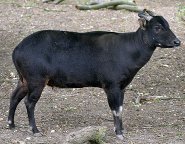 The Anoa (Bubalus depressicornis), living in Indonesia are similar to water buffalo. In Indonesia, they enjoy the rainforest, which has not yet been devastated by man. Weighing 150-300 kg (330-660 lbs), these four-legged mammals resemble deer in appearance. Most Anoa reside on the island of Sulawesi in the Southern Pacific Ocean. However, there are a few which are found on Buton, another Indonesian island.
The Anoa (Bubalus depressicornis), living in Indonesia are similar to water buffalo. In Indonesia, they enjoy the rainforest, which has not yet been devastated by man. Weighing 150-300 kg (330-660 lbs), these four-legged mammals resemble deer in appearance. Most Anoa reside on the island of Sulawesi in the Southern Pacific Ocean. However, there are a few which are found on Buton, another Indonesian island.The Anoa segregate themselves into two groups. Similar to the old clans in Scotland, there are highlanders and lowlanders. All of the Anoa on Buton are highlanders, going by the name Mountain Anoia. Different people have given the Mountain Anoa varying names, one of which is Anoa de Montana (Anoa of the Mountain). Although there are many different names for this Anoa, these reflect the variety of societies and languages in the area, not the Anoa's diversity. There are only the highlanders and lowlanders. While Buton has only Mountain Anoa, both species live on Sulawesi.
The other main difference between the two Anoas is their size. The Lowland Anoa are some of the smallest wild cattle. They stand only 90 cm tall (35 in.) at the shoulder, perhaps more closely resembling a young fawn in appearance than a fully grown buck. In contrast, the Mountain Anoa are more similar to mature deer in their stature.
The Anoa is a largely unknown animal. Although they have been studied by researchers and are known by the people of Indonesia, most of the world is unfamiliar with these animals. A lack of appreciation for these creatures has combined with their solitary lifestyle and low reproduction rate to their decline. The Anoa are endangered. Since the 1960s, their population has fallen. Estimates today are around 10,000 for the total population of both species combined. The two factors contributing to the Anoa's decline are the destruction of their rain forest environment and hunting.
Hopefully with proper education, people will come to know and appreciate the Anoa.
Picture of the lowland Anoa by 'The Land', photographed May 2011 in Marwell Zoo, Hampshire, UK., licensed under Creative Commons Attribution-Share Alike 3.0 Unported license.
Which zoos have them?
Artis (Netherlands)The Anoa, lowland anoa is listed as Endangered (EN), considered to be facing a very high risk of extinction in the wild, on the IUCN Red List of Threatened Species
Countries
IndonesiaAnoa habitats
Shrubland, Subtropical / Tropical Dry Shrubland and Subtropical / Tropical Moist ShrublandSome facts about the
Anoa
Adult weight : 155 kg (341 lbs)
Maximum longevity : 36 years
Female maturity :730 days
Male maturity : 730 days
Gestation : 300 days
Litter size : 1

Custom Search